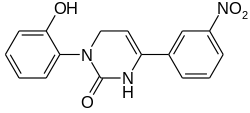Icilin
 | |
| Names | |
|---|---|
| IUPAC name
1-(2-hydroxyphenyl)-4-(3-nitrophenyl)-3,6-dihydropyrimidin-2-one | |
| Other names
AG-3-5 | |
| Identifiers | |
| 36945-98-9 | |
| ChemSpider | 142218 |
| |
| IUPHAR ligand | 2429 |
| Jmol-3D images | Image |
| PubChem | 161930 |
| |
| Properties | |
| C16H13N3O4 | |
| Molar mass | 311.29 g/mol |
| Except where noted otherwise, data is given for materials in their standard state (at 25 °C (77 °F), 100 kPa) | |
| | |
| Infobox references | |
Icilin is a synthetic super-agonist of the transient receptor potential M8 (TRPM8) ion channel. Although structurally not related with menthol it produces an extreme sensation of cold both in humans and animals. It is almost 200 times more potent than menthol and 2.5 times more efficacious.[1] Despite their similar effects icilin activates the TRPM8 receptor in a different way.[2] Icilin is effective in an experimental model of itch.[3] It is now used as a research tool for the study of TRP channels.
References
- ↑ Wei ET, Seid DA (1983). "AG-3-5: a chemical producing sensations of cold". J. Pharm. Pharmacol. 35 (2): 110–2. PMID 6131976.
- ↑ Andersson DA, Chase HW, Bevan S (2004). "TRPM8 activation by menthol, icilin, and cold is differentially modulated by intracellular pH". J. Neurosci. 24 (23): 5364–9. doi:10.1523/JNEUROSCI.0890-04.2004. PMID 15190109.
- ↑ Biró, T; Ko, MC; Bromm, B; Wei, ET; Bigliardi, P; Siebenhaar, F; Hashizume, H; Misery, L et al. (2005). "How best to fight that nasty itch - from new insights into the neuroimmunological, neuroendocrine, and neurophysiological bases of pruritus to novel therapeutic approaches". Experimental Dermatology 14 (3): 225–40. doi:10.1111/j.0906-6705.2005.0321a.x. PMID 15740597.